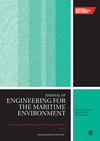基于同向旋转坐标法的深层陡立管可行性分析
IF 1.5
4区 工程技术
Q3 ENGINEERING, MARINE
Proceedings of the Institution of Mechanical Engineers, Part M: Journal of Engineering for the Maritime Environment
Pub Date : 2024-04-02
DOI:10.1177/14750902241240210
引用次数: 0
摘要
深陡立管(DSR)是一种新型立管结构,可减少由立管自重引起的超高张力载荷。本文研究了不同浮力模块配置和不同洋流条件下 DSR 的力学行为。基于共旋转坐标法建立了 DSR 的有限元模型。模型采用弧长法求解。数值方法的准确性通过 Abaqus 软件进行了验证。然后,分析了浮力模块长度和浮力系数对 DSR 的影响。最后,评估了不同水流入射角和流速对 DSR 的影响。结果表明,基于共旋转坐标法的 DSR 模型能有效模拟 DSR 大变形的非线性行为。该方法简单、灵活、计算效率高。该方法可快速提高深水立管静力分析中的数值计算效率。在一定条件下,DSR 是可行的。本文章由计算机程序翻译,如有差异,请以英文原文为准。
Feasibility analysis of deep steep riser based on co-rotational coordinate method
DSR (Deep steep riser) is a new riser structure that reduces the ultra-high-tension load caused by the riser self-weight. In this paper, the mechanical behavior of DSR under different buoyancy module configurations and different ocean currents is studied. The finite element model of DSR is established based on co-rotational coordinate method. The model is solved by arc length method. The accuracy of the numerical method is verified by Abaqus software. Then, the effects of buoyancy module length and buoyancy factor on DSR are analyzed. Finally, the influence of different current incidence angles and velocities on DSR is evaluated. The results show that the DSR model based on the co-rotational coordinate method can effectively simulate the nonlinear behavior of large deformation of DSR. The method is simple, flexible and computationally efficient. This method can quickly improve the efficiency of numerical calculation in static analysis of deepwater riser. And DSR is feasible under certain conditions.
求助全文
通过发布文献求助,成功后即可免费获取论文全文。
去求助
来源期刊

CiteScore
3.90
自引率
11.10%
发文量
77
审稿时长
>12 weeks
期刊介绍:
The Journal of Engineering for the Maritime Environment is concerned with the design, production and operation of engineering artefacts for the maritime environment. The journal straddles the traditional boundaries of naval architecture, marine engineering, offshore/ocean engineering, coastal engineering and port engineering.
 求助内容:
求助内容: 应助结果提醒方式:
应助结果提醒方式:


